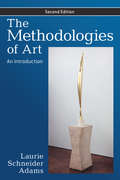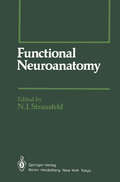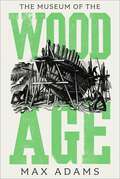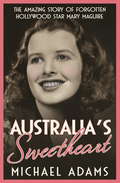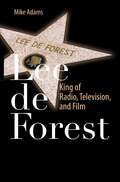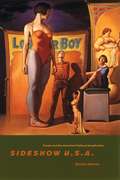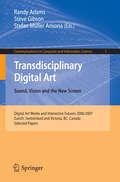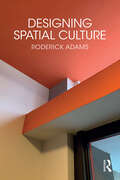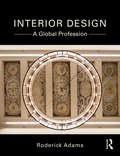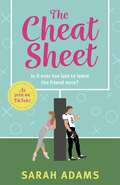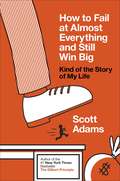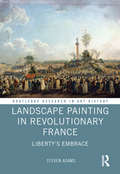- Table View
- List View
Art And Psychoanalysis (Icon Editions)
by Laurie Schneider AdamsA pioneering overview of art and psychoanalysis that shows how each field can enrich and enlarge the other.
Italian Renaissance Art
by Laurie Schneider AdamsNow thoroughly revised and updated throughout, featuring extended discussions of Mannerism and the expanding role of women in the visual arts and significant illustration program enhancements, Italian Renaissance Art is a readable, student-friendly, lavishly-illustrated introduction to one of the greatest periods of artistic genius in western history.Art historian Laurie Schneider Adams opens the text with the late Byzantine work of Cimabue and concludes with the transition to Mannerism. The author presents the most important and innovative artists and their principal works, with a clear emphasis on selectivity and understanding. Italian Renaissance Art also focuses on style and iconography, and on art and artists, incorporating different methodological approaches to create a wider understanding and appreciation of the art.Distinguishing features of the second edition include:More than 400 images throughout the work, with over 300 in full-color. Over 50 images were changed from black and white to full-color for this edition. Illustration program now includes works by Correggio, Bronzino, and Pontormo.Large format illustrations retained for readability and visual access by students. Design changes make the text more attractive and readable.?Connections,? with thumbnail images of earlier works, show the historical continuity of the images. ?Comparison? thumbnails have also been added for the purpose of comparing and contrasting later works with earlier ones.New treatment of Mannerism and the expanding role of women in the visual arts. Coverage includes Lavinia Fontana, Sofonisba Anguissola, and Properzia de' Rossi, and a new feature box discusses the role of Isabella d'Este as an influential art patron and humanist.Maps, plans, and diagrams included throughout. Also features a historical chronology, a full glossary of art-historical terms, and a select bibliography.
Key Monuments Of The Baroque
by Laurie Schneider AdamsThis book focuses on key monuments of the Baroque style, which varies in different European contexts. It is intended to affirm the existence of individual genius, identifiable styles of art, and historical periods that produced them.
Key Monuments Of The Baroque
by Laurie Schneider AdamsThis book focuses on key monuments of the Baroque style, which varies in different European contexts. It is intended to affirm the existence of individual genius, identifiable styles of art, and historical periods that produced them.
Key Monuments Of The Italian Renaissance
by Laurie Schneider AdamsOrganized chronologically from early Renaissance precursors to the Mannerist movement, from Giotto to Titian, Key Monuments of the Italian Renaissance describes and analyzes in depth from various points of view major works and major artists, from the fourteenth to the sixteenth centuries. Artists included are Cimabue, Duccio, Giotto, Lorenzetti, Gh
Key Monuments Of The Italian Renaissance
by Laurie Schneider AdamsOrganized chronologically from early Renaissance precursors to the Mannerist movement, from Giotto to Titian, Key Monuments of the Italian Renaissance describes and analyzes in depth from various points of view major works and major artists, from the fourteenth to the sixteenth centuries. Artists included are Cimabue, Duccio, Giotto, Lorenzetti, Gh
The Methodologies of Art: An Introduction
by Laurie Schneider AdamsSince the nineteenth century, when art history became an established academic discipline, works of art have been ?read? in a variety of ways. These different ways of describing and interpreting art are the methodologies of artistic analysis, the divining rods of meaning. Regardless of a work's perceived difficulty, an art object is, in theory, complex. Every work of art is an expression of its culture (time and place) and its maker (the artist) and is dependent on its media (what it's made of). The methodologies discussed here?formal analysis, iconology and iconography, Marxism, feminism, biography and autobiography, psychoanalysis, structuralism, race and gender?reflect the multiplicity of meanings in an artistic image. The second edition includes nineteen new images, new sections on race, gender, orientalism, and colonialism, and a new epilogue that analyzes a single painting to illustrate the different methodological viewpoints.
The Methodologies of Art: An Introduction
by Laurie Schneider AdamsSince the nineteenth century, when art history became an established academic discipline, works of art have been ?read? in a variety of ways. These different ways of describing and interpreting art are the methodologies of artistic analysis, the divining rods of meaning. Regardless of a work's perceived difficulty, an art object is, in theory, complex. Every work of art is an expression of its culture (time and place) and its maker (the artist) and is dependent on its media (what it's made of). The methodologies discussed here?formal analysis, iconology and iconography, Marxism, feminism, biography and autobiography, psychoanalysis, structuralism, race and gender?reflect the multiplicity of meanings in an artistic image. The second edition includes nineteen new images, new sections on race, gender, orientalism, and colonialism, and a new epilogue that analyzes a single painting to illustrate the different methodological viewpoints.
Functional Neuroanatomy (Springer Series in Experimental Entomology)
by M. E. Adams J. S. Altman J. P. Bacon U. K. Bassemir C. A. Bishop E. Buchner H. Bülthoff S. D. Carlson Chi Che F. DelComyn H. Duve M. Eckert T.R.J. Flanagan G. Geiger C. H. Hackney B. Hengstenberg R. Hengstenberg N. Klemm D. R. Nässel M. O Shea W. A. Ribi R.L. Saint Marie H. S. Seyan P. T. Speck N. J. Strausfeld A. Thorpe J. Ude D. W. WohlersThe "functional" in the title of this book not only reflects my personal bias about neuroanatomy in brain research, it is also the gist of many chapters which describe sophisticated ways to resolve structures and interpret them as dynamic entities. Examples are: the visualization of functionally identified brain areas or neurons by activity staining or intracellular dye-iontophoresis; the resolution of synaptic connections between physiologically identified nerve cells; and the biochemical identification of specific neurons (their peptides and transmitters) by histo- and immunocytochemistry. I personally view the nervous system as an organ whose parts, continuously exchanging messages, arrive at their decisions by the cooperative phenome non of consensus and debate. This view is, admittedly, based on my own ex perience of looking at myriads of nerve cells and their connections rather than studying animal behaviour or theorizing. Numerous structural studies have demonstrated that interneurons in the brain must receive hundreds of thousands of synapses. Many neurons receive inputs from several different sensory areas: each input conveys a message about the external world and possibly also about past events which are stored within the central nervous system. Whether an interneuron responds to a certain combination of inputs may be, literally, a matter of debate whose outcome is decided at the post synaptic membrane. A nerve cell responding to an overriding command is possibly a rare event.
Fashion Jewellery: Catwalk And Couture (Pocket Editions)
by Maia AdamsFashion jewellery is created with the catwalk and couture in mind, characterized by its creativity and originality. It is arguably the most exciting field in fashion today. Arranged by designer, this is the first book to showcase contemporary catwalk and couture jewellery, profiling 33 international fashion jewellers who combine traditional techniques and ultra-modern methods to create this new style of jewellery. Among the stunning images of work shown are collaborations with leading fashion designers and brands such as Lanvin, Vivienne Westwood, Alexander McQueen and Comme des Garçons, as well as collections for directional fashion stores such as Colette and 10 Corso Como. Fashion Jewellery will provide inspiration for designers, jewellers and students of fashion, offering a unique insight into the working methods and inspirations of a new generation of jewellers. Showcasing skilled craftsmanship, unusual materials and an often limited-edition approach Fashion Jewellery harnesses the spirit of couture for the 21st century.
The Museum of the Wood Age
by Max AdamsA passionate and imaginative exploration of wood – the material that shaped human history.As a material, wood has no equal in strength, resilience, adaptability and availability. It has been our partner in the cultural evolution from woodland foragers to engineers of our own destiny. Tracing that partnership through tools, devices, construction and artistic expression, Max Adams explores the role that wood has played in our own history as an imaginative, curious and resourceful species.Beginning with an investigation of the material properties of various species of wood, The Museum of the Wood Age investigates the influence of six basic devices – wedge, inclined plane, screw, lever, wheel, axle and pulley – and in so doing reveals the myriad ways in which wood has been worked throughout human history. From the simple bivouacs of hunter-gatherers to sophisticated wooden buildings such as stave churches; from the decorative arts to the humble woodworking of rustic furniture; Max Adams fashions a lattice of interconnected stories and objects that trace a path of human ingenuity across half a million years of history.
Australia's Sweetheart: The amazing story of forgotten Hollywood star Mary Maguire
by Michael AdamsThis is the fascinating story of Mary Maguire, a 1930s Australian ingenue who sailed for Hollywood and a fabulous life, only to have her career cut short by scandal and tragedy. Packed with celebrity, history and gossip, AUSTRALIA'S SWEETHEART is perfect for readers of SHEILA and THE RIVIERA SET.Mary Maguire was Australia's first teenage movie star and she captivated Hollywood in the mid 1930s. Mary lived on three continents and was celebrated in Melbourne, Brisbane, Sydney, Los Angeles and London. Her life was lived in parallel with seminal incidents of the twentieth century: the Spanish Flu; the Great Depression; the Bodyline series; Australia's early radio, talkies and aviation; Hollywood's Golden Era; the British aristocracy's embrace of European fascism; London's Blitz; and post-war American culture and politics. Mary knew everyone, from Douglas Jardine, Don Bradman, Errol Flynn and Ronald Reagan, to William Randolph Hearst, Maureen O'Sullivan, Judy Garland and Queen Elizabeth II.AUSTRALIA'S SWEETHEART in an irresistible never-before-told story that captures the glamour of Hollywood and the turbulent times of the twentieth century, with a young woman at its centre. If you loved THE AMAZING MRS LIVESEY, Robert Wainwright's SHEILA and MISS MURIEL MATTERS, you will adore AUSTRALIA'S SWEETHEART.
Lee de Forest: King of Radio, Television, and Film
by Mike AdamsThe life-long inventor, Lee de Forest invented the three-element vacuum tube used between 1906 and 1916 as a detector, amplifier, and oscillator of radio waves. Beginning in 1918 he began to develop a light valve, a device for writing and reading sound using light patterns. While he received many patents for his process, he was initially ignored by the film industry. In order to promote and demonstrate his process he made several hundred sound short films, he rented space for their showing; he sold the tickets and did the publicity to gain audiences for his invention. Lee de Forest officially brought sound to film in 1919. Lee De Forest: King of Radio, Television, and Film is about both invention and early film making; de Forest as the scientist and producer, director, and writer of the content. This book tells the story of de Forest’s contribution in changing the history of film through the incorporation of sound. The text includes primary source historical material, U.S. patents and richly-illustrated photos of Lee de Forest’s experiments. Readers will greatly benefit from an understanding of the transition from silent to audio motion pictures, the impact this had on the scientific community and the popular culture, as well as the economics of the entertainment industry.
The Emptiness of the Image: Psychoanalysis and Sexual Differences
by Parveen AdamsThere has long been a politics around the way in which women are represented, with objection not so much to specific images as to a regime of looking which places the represented woman in a particular relationship to the spectator's gaze. Artists have sometimes avoided the representation of women altogether, but they are now producing images which challenge the regime. How do these images succeed in their challenge ? The Emptiness of the Image offers a psychoanalytic answer. Parveen Adams argues that, despite flaws in some of the details of its arguments, psychoanalytic theory retains an overwhelming explanatory strength in relation to questions of sexual difference and representation. She goes on to show how the issue of desire changes the way we can think of images and their effects. Throughout she discusses the work of theorists, artists and filmmakers such as Helene Deutsch, Catherine MacKinnon, Mary Kelly, Francis Bacon, Michael Powell and Della Grace. The Emptiness of the Image shows how the very space of representation can change to provide a new way of thinking the relation between the text and the spectator. It shows how psychoanalytic theory is supple enough to slide into and transform the most unexpected situations.
The Emptiness of the Image: Psychoanalysis and Sexual Differences
by Parveen AdamsThere has long been a politics around the way in which women are represented, with objection not so much to specific images as to a regime of looking which places the represented woman in a particular relationship to the spectator's gaze. Artists have sometimes avoided the representation of women altogether, but they are now producing images which challenge the regime. How do these images succeed in their challenge ? The Emptiness of the Image offers a psychoanalytic answer. Parveen Adams argues that, despite flaws in some of the details of its arguments, psychoanalytic theory retains an overwhelming explanatory strength in relation to questions of sexual difference and representation. She goes on to show how the issue of desire changes the way we can think of images and their effects. Throughout she discusses the work of theorists, artists and filmmakers such as Helene Deutsch, Catherine MacKinnon, Mary Kelly, Francis Bacon, Michael Powell and Della Grace. The Emptiness of the Image shows how the very space of representation can change to provide a new way of thinking the relation between the text and the spectator. It shows how psychoanalytic theory is supple enough to slide into and transform the most unexpected situations.
Sideshow U.S.A.: Freaks and the American Cultural Imagination
by Rachel AdamsA staple of American popular culture during the nineteenth and early twentieth centuries, the freak show seemed to vanish after the Second World War. But as Rachel Adams reveals in Sideshow U.S.A., images of the freak show, with its combination of the grotesque, the horrific, and the amusing, stubbornly reappeared in literature and the arts. Freak shows, she contends, have survived because of their capacity for reinvention. Empty of any inherent meaning, the freak's body becomes a stage for playing out some of the twentieth century's most pressing social and political concerns, from debates about race, empire, and immigration, to anxiety about gender, and controversies over taste and public standards of decency. Sideshow U.S.A. begins by revisiting the terror and fascination the original freak shows provided for their audiences, as well as exploring the motivations of those who sought fame and profit in the business of human exhibition. With this history in mind, Adams turns from live entertainment to more mediated forms of cultural expression: the films of Tod Browning, the photography of Diane Arbus, the criticism of Leslie Fiedler, and the fiction Carson McCullers, Toni Morrison, and Katherine Dunn. Taken up in these works of art and literature, the freak serves as a metaphor for fundamental questions about self and other, identity and difference, and provides a window onto a once vital form of popular culture. Adams's study concludes with a revealing look at the revival of the freak show as live performance in the late 1980s and the 1990s. Celebrated by some, the freak show's recent return is less welcome to those who have traditionally been its victims. At the beginning of a new century, Adams sees it as a form of living history, a testament to the vibrancy and inventiveness of American popular culture, as well as its capacity for cruelty and injustice. "Because of its subject matter, this interesting and complex study is provocative, as well as thought-provoking."—Virginia Quarterly Review
Transdisciplinary Digital Art: Sound, Vision and the New Screen (Communications in Computer and Information Science #7)
by Randy Adams Steve Gibson Stefan Müller ArisonaThis volume collects selected papers from the past two instances of Digital Art Weeks (Zurich, Switzerland) and Interactive Futures (Victoria, BC, Canada), two parallel festivals of digital media art. The work represented in Transdisciplinary Digital Art is a confirmation of the vitality and breadth of the digital arts. Collecting essays that broadly encompass the digital arts, Transdisciplinary Digital Art gives a clear overview of the on-going strength of scientific, philosophical, aesthetic and artistic research that makes digital art perhaps the defining medium of the 21st Century.
Designing Spatial Culture
by Roderick AdamsDesigning Spatial Culture investigates a powerful experiential dialogue formed between the habitation of space and a diversified cultural realm. This creative proposition binds and positions human activity and experience framing its histories, currency and future. Whilst the book distinguishes between the conditions of the existing urban/ architecture/ interior canon, it embraces a new agency of space, showcasing the encounters, assemblies and designs that shape human behaviours and the cultural forms of the built environment. Using authoritative case studies, the book examines many locations and spaces, ranging from new urban landscapes, historical domestic spaces and contemporary architecture. It embraces the most lavish and flamboyant to the most simplistic and minimal, establishing a connected cultural narrative. The book shifts the focus in the spatial realm from an object-based experience (where space is filled with things) to a more complete immersive experience (combining physical and digital). A key part of this exploration is the relationship between the architecture and the interior which is often the most predominant spatial experience and fundamental to the understanding spatial experience and existing cultures. Without the architectural enclosure, the interior would lose its site context and structure for its existence. Without an interior, architecture would not fully develop an engaging spatial experience for the user. The book rationalises this through extended use of a spatial probe which documents and summarises an evidence-based research project capturing spatial culture data from a predominantly domestic setting. The book is essential reading for students and researchers in architecture, interior design and urban design.
Designing Spatial Culture
by Roderick AdamsDesigning Spatial Culture investigates a powerful experiential dialogue formed between the habitation of space and a diversified cultural realm. This creative proposition binds and positions human activity and experience framing its histories, currency and future. Whilst the book distinguishes between the conditions of the existing urban/ architecture/ interior canon, it embraces a new agency of space, showcasing the encounters, assemblies and designs that shape human behaviours and the cultural forms of the built environment. Using authoritative case studies, the book examines many locations and spaces, ranging from new urban landscapes, historical domestic spaces and contemporary architecture. It embraces the most lavish and flamboyant to the most simplistic and minimal, establishing a connected cultural narrative. The book shifts the focus in the spatial realm from an object-based experience (where space is filled with things) to a more complete immersive experience (combining physical and digital). A key part of this exploration is the relationship between the architecture and the interior which is often the most predominant spatial experience and fundamental to the understanding spatial experience and existing cultures. Without the architectural enclosure, the interior would lose its site context and structure for its existence. Without an interior, architecture would not fully develop an engaging spatial experience for the user. The book rationalises this through extended use of a spatial probe which documents and summarises an evidence-based research project capturing spatial culture data from a predominantly domestic setting. The book is essential reading for students and researchers in architecture, interior design and urban design.
Interior Design: A Global Profession
by Roderick AdamsAs the globe shrinks and the concept of distance diminishes, this text challenges the current status quo by identifying the cohesions and specialisations of design communities across the continents. It sets out an international spatial design landscape, identifying and contouring global design practice and design hotspots from a range of case studies, interviews and design practice perspectives. Using a range of interior environments, the chapters link the origins, trends and perceptions of the interior to create new insight into trans-global design. The book expands, but also coheres the interior design discipline to ensure the subject continues to grow, develop and influence the inhabitations of the world. The book features a wealth of pedagogical elements including: Beautifully designed with over 100 full colour illustrations, photographs and examples of design work Maps and diagrams which highlight hotspots of design across the globe, providing strong graphic information Interview panels featuring professional insights from designers across the globe ‘Employability’ boxes, providing a good tips guide for students gaining employment across the globe ‘International Dimension’ boxes which strengthen the scholarship of studying interior design in a globalised way ‘Design Oddities’ box which brings into focus any new or contextual facts that help contextualise the global interior.
Interior Design: A Global Profession
by Roderick AdamsAs the globe shrinks and the concept of distance diminishes, this text challenges the current status quo by identifying the cohesions and specialisations of design communities across the continents. It sets out an international spatial design landscape, identifying and contouring global design practice and design hotspots from a range of case studies, interviews and design practice perspectives. Using a range of interior environments, the chapters link the origins, trends and perceptions of the interior to create new insight into trans-global design. The book expands, but also coheres the interior design discipline to ensure the subject continues to grow, develop and influence the inhabitations of the world. The book features a wealth of pedagogical elements including: Beautifully designed with over 100 full colour illustrations, photographs and examples of design work Maps and diagrams which highlight hotspots of design across the globe, providing strong graphic information Interview panels featuring professional insights from designers across the globe ‘Employability’ boxes, providing a good tips guide for students gaining employment across the globe ‘International Dimension’ boxes which strengthen the scholarship of studying interior design in a globalised way ‘Design Oddities’ box which brings into focus any new or contextual facts that help contextualise the global interior.
The Cheat Sheet: TikTok made me buy it! The romcom hit of 2022!
by Sarah AdamsIs it ever too late to leave the friend zone? Friends-to-lovers TikTok sensation, The Cheat Sheet, is the rom-com that has readers laughing and rooting for these lovable best friends from the first page! 'A laugh-out-loud romantic comedy' SOPHIE SULLIVAN'As slapstick funny as it is both sizzling and sweet, this best-friends-to-lovers sports romance brings its RomCom A-game' CHLOE LIESE'The perfect mix of laugh-out-loud entertaining and intensely tender' DEVON DANIELS.................................................................................The friend zone is not the end zone for Bree Camden, who is helplessly in love with her longtime best friend and extremely hot NFL legend, Nathan Donelson. The only problem is that she can't admit her true feelings, because he clearly sees her as a best friend with no romantic potential, and the last thing Bree wants is to ruin their relationship. But those abs . . . Nope! Nothing but good old-fashioned, no-touching-the-sexiest-man-alive, platonic friendship for Bree. In any case, she has other things to worry about. After a car accident ended her chance at becoming a professional ballerina, Bree changed paths and now owns her own dance studio, with big dreams to expand it. But one more rent increase could mean the end of the studio entirely. Then, as usual, Nathan comes to the rescue and buys the entire building. A stubborn Bree is not happy about it and decides to rebel with a couple - okay, maybe more than a couple - of tequila shots. Then her plan backfires as she spills her deepest, darkest secret to a TMZ reporter. One viral video later, the world thinks Nathan and Bree are the perfect couple. Before they can really talk about her confession, Nathan's publicist proposes a big opportunity that could mean financial security for Bree. The catch? They have to pretend to be in love. For three whole weeks. What will happen when Bree gives in to the feelings she's been desperately hiding for so long, and could she be imagining that Nathan is actually enjoying it? Discover the heartwarming friends to lovers romance that became a sensation on TikTok!
How to Fail at Almost Everything and Still Win Big: Kind of the Story of My Life
by Scott AdamsDilbert creator Scott Adams' funny memoir about his many failures and what they eventually taught him about successScott Adams has probably failed at more things than anyone you've ever met. So how did he go from hapless office worker and serial failure to the creator of Dilbert, one of the world's most famous comic strips, in just a few years?No career guide can offer advice that works for everyone. Your best bet is to study the ways of others who made it big and try to glean some tricks that make sense for you. So here Scott Adams tells how he turned one failure after another - including a corporate career, inventions, investments, and two restaurants - into something successful. Along the way he discovered some unlikely truths. Goals are for losers; systems are for winners. Forget 'passion'; what you need is personal energy.In this brilliant book, Adams shows us how to invite failure in, embrace it, then pick its pocket. While you laugh at his failures, you'll discover some helpful ideas for your own path to personal victory.
Landscape Painting in Revolutionary France: Liberty's Embrace (Routledge Research in Art History)
by Steven AdamsThe French Revolution had a marked impact on the ways in which citizens saw the newly liberated spaces in which they now lived. Painting, gardening, cinematic displays of landscape, travel guides, public festivals, and tales of space flight and devilabduction each shaped citizens’ understanding of space. Through an exploration of landscape painting over some 40 years, Steven Adams examines the work of artists, critics and contemporary observers who have largely escaped art historical attention to show the importance of landscape as a means of crystallising national identity in a period of unprecedented political and social change.
Landscape Painting in Revolutionary France: Liberty's Embrace (Routledge Research in Art History)
by Steven AdamsThe French Revolution had a marked impact on the ways in which citizens saw the newly liberated spaces in which they now lived. Painting, gardening, cinematic displays of landscape, travel guides, public festivals, and tales of space flight and devilabduction each shaped citizens’ understanding of space. Through an exploration of landscape painting over some 40 years, Steven Adams examines the work of artists, critics and contemporary observers who have largely escaped art historical attention to show the importance of landscape as a means of crystallising national identity in a period of unprecedented political and social change.




